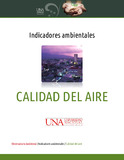| dc.creator | Valdés, Juan | es_ES |
| dc.creator | Esquivel Hernández, Germain | es_ES |
| dc.creator | Morales Rivera, José | es_ES |
| dc.date.accessioned | 2013-08-22T20:14:07Z | |
| dc.date.available | 2013-08-22T20:14:07Z | |
| dc.date.created | 2013-07-31T11:39:25-06:00 | es_ES |
| dc.date.issued | 2013-08-22 | |
| dc.identifier.uri | http://hdl.handle.net/11056/7458 | |
| dc.description.abstract | Las emisiones de contaminantes atmosféricos provenientes desde fuentes fijas están reguladas por el Reglamento sobre Emisión de Contaminantes Atmosféricos provenientes de Calderas (DE-30222-S-MINAE). La normativa presente en este reglamento es aplicable a calderas que pueden utilizar combustibles fósiles o biomásicos (La Gaceta, 2002) e incluye tres contaminantes primarios atmosféricos: el dióxido de azufre (SO2), los óxidos de nitrógeno (NOx) y las partículas totales en suspensión (PTS). Las calderas son las fuentes de generación de energía más utilizadas en Costa Rica, por lo que las emisiones correspondientes a su uso pueden afectar de manera significativa la calidad del aire y la salud de la población en general.
Actualmente la cuantificación de las emisiones provenientes de este tipo de fuentes fijas se realiza sistemáticamente por parte del Ministerio de Salud, y a través de las mediciones in situ que varios laboratorios nacionales prestan como servicio a la industria nacional. Sin embargo, esta información no se ha sistematizado o empleado para la generación de un inventario de emisiones atmosféricas, que por lo menos incluya la tres contaminantes regulados en el Reglamento arriba mencionado.
Tomando como base los análisis realizados en el 2008, 2009 y 2010, el Laboratorio de Química de la Atmósfera de la Universidad Nacional ha preparado un inventario nacional parcial de las emisiones atmosféricas provenientes de fuentes fijas, en el cual se cuantifican en toneladas por año, la cantidad de NOx, SO2 y PTS que se emitieron al aire por las industrias a las que el LAQAT-UNA prestó su servicio. El objetivo general de este trabajo es exponer la metodología empleada para la estimación de las emisiones anuales de estos contaminantes, con base en los datos actualmente disponibles en el LAQAT-UNA, así como sentar las bases para el desarrollo de un inventario nacional, utilizando los datos recopilados por el Ministerio de Salud durante cada año. Este inventario garantizaría el diseño y ejecución de una campaña permanente de medición de gases de combustión y partículas en chimeneas a nivel industrial para fuentes caracterizadas como grandes emisores (nuevos y existentes), al mismo tiempo que permitiría aplicar otras herramientas para el control de emisiones desde fuentes fijas, tales como la validación de los inventarios generados mediante el la modelación de la dispersión de contaminantes estudiados (Parra, 2004). | es_ES |
| dc.description.abstract | Emissions of atmospheric pollutants from stationary sources are regulated by the Regulation on Emission of Atmospheric Pollutants from Boilers (DE-30222-S-MINAE). The regulations present in this regulation are applicable to boilers that can use fossil or biomass fuels (La Gaceta, 2002) and include three primary atmospheric pollutants: sulfur dioxide (SO2), nitrogen oxides (NOx) and total particles in suspension (PTS). Boilers are the most widely used sources of power generation in Costa Rica, so the emissions corresponding to their use can significantly affect air quality and the health of the general population. Currently, the quantification of emissions from this type of fixed sources is carried out systematically by the Ministry of Health, and through on-site measurements that various national laboratories provide as a service to the national industry. However, this information has not been systematized or used to generate an inventory of atmospheric emissions, which at least includes the three pollutants regulated in the above-mentioned Regulation. Based on the analyzes carried out in 2008, 2009 and 2010, the Atmospheric Chemistry Laboratory of the National University has prepared a partial national inventory of atmospheric emissions from stationary sources, in which they are quantified in tons per year, the amount of NOx, SO2 and PTS that were released to the air by the industries that LAQAT-UNA served. The general objective of this work is to present the methodology used to estimate the annual emissions of these pollutants, based on the data currently available in LAQAT-UNA, as well as to lay the foundations for the development of a national inventory, using the data collected by the Ministry of Health during each year. This inventory would guarantee the design and execution of a permanent campaign to measure combustion gases and particles in chimneys at an industrial level for sources characterized as large emitters (new and existing), at the same time that it would allow the application of other tools for the control of emissions from fixed sources, such as the validation of the inventories generated by modeling the dispersion of pollutants studied (Parra, 2004). | en_US |
| dc.format.mimetype | application/pdf | es_ES |
| dc.language | es | es_ES |
| dc.rights | Atribución-NoComercial-CompartirIgual 3.0 Costa Rica (CC BY-NC-SA 3.0 CR) | es_ES |
| dc.rights.uri | http://creativecommons.org/licenses/by-nc-sa/3.0/cr/ | |
| dc.subject | CONTAMINACIÓN DEL AIRE | |
| dc.subject | CONTAMINANTES | |
| dc.subject | INVENTARIO | |
| dc.subject | SULFUR DIOXIDE | |
| dc.subject | ATMOSPHERIC EMISSIONS | |
| dc.subject | ATMOSPHERIC POLLUTANTS | |
| dc.title | Emisiones de contaminantes atmosféricos provenientes desde fuentes fijas | es_ES |
| dc.type | http://purl.org/coar/resource_type/c_6501 | es_ES |


